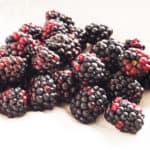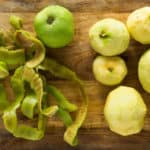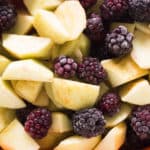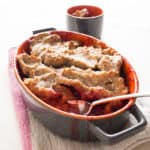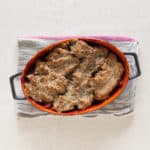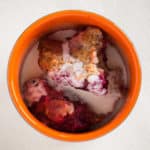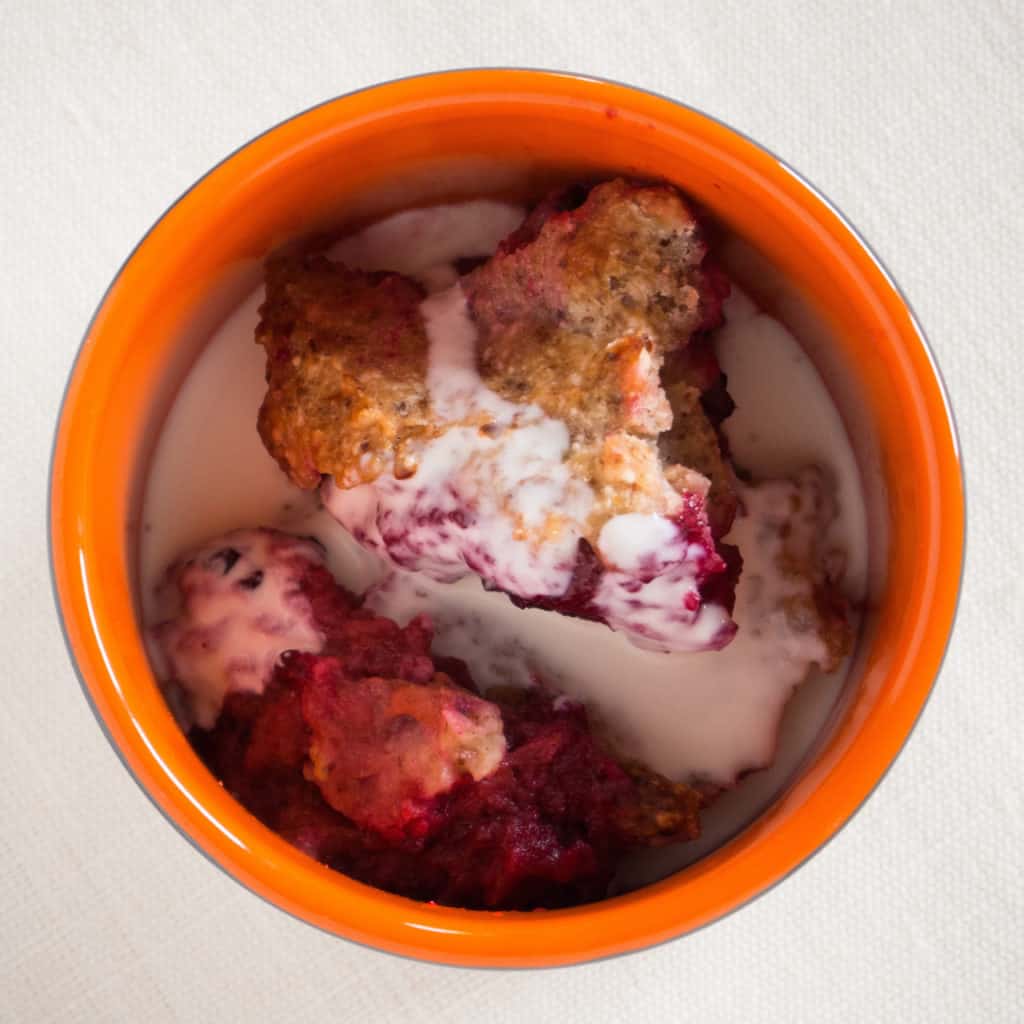
Apple and Blackberry Cobbler is as British as… Apple Pie. Apples and blackberries are the perfect combination, both are beautifully in season in September and taste wonderful so let’s make the most of them. Yeh!
Apple and Blackberry Cobbler is quick and easy to make.
You can find the full Apple and Blackberry Cobbler recipe here.
Perfect for a special occasions and desserts anytime. Serve with the vegan cream filling from the Eaton Mess recipe (minus the strawberries). Also a great way to follow Endive Salad with Pears and Almondsor Grilled Nectarine Salad with Rocket and Walnuts.
My Apple and Blackberry Cobbler recipe does not precook the fruit. Personally I don’t like mush in the bottom of my cobblers, crumbles or any other fruit dessert. Pre-cooking fruit removes any texture and all the flavour from the pudding – so don’t do it!. I also do not use very much sugar in the fruit. Blackberries need a little bit of sugar but not too much. Just enough to take the edge of the lip sucking sourness!
Top tip. Don’t totally cover the fruit with the cobbler topping. Part of the beauty of cobber is the fruit peeping through the top layer.
h1>Preparation
Difficulty easy
Preparation time 5 minutes
Cooking time 50 minutes
You can find the full Apple and Blackberry Cobbler recipe here.
h1>Allergens
Apple and Blackberry Cobbler is gluten-free and vegan as well as…
Celery free
Coconut free
Garlic free
Lupin free
Mustard free
Nightshade free
Onion free
Peanut free
Sesame free
Soya free
Tree nut free
What’s the Deal with Apples?
Apples are not native to the UK (not much is!) however, apples are thought of as quintessentially British fruit (along with bananas and pineapple but that’s another story). Apples do grown very well in the UK and have adapted to our wonderful climate very well.
Apple trees are large if grown from seed. Generally apple cultivars are propagated by grafting onto rootstocks, which control the size of the resulting tree. There are more than 7,500 known cultivars of apples, resulting in a range of desired characteristics. Different cultivars are bred for various tastes and uses, including cooking, eating raw and cider production. Trees and fruit are prone to a number of fungal, bacterial and pest problems, which can be controlled by a number of organic and non-organic means.
What are apples?
The apple tree (Malus pumila) is a deciduous tree in the rose family best known for its sweet, pomaceous fruit, the apple. It is cultivated worldwide as a fruit tree, and is the most widely grown species in the genus Malus.
Origins and spread of apples
The apple tree originated in Central Asia, where its wild ancestor, Malus sieversii, is still found today. Apples have been grown for thousands of years in Asia and Europe, and were brought to North America by European colonists. Apples have religious and mythological significance in many cultures, including Norse, Greek and European Christian traditions.
The centre of diversity of the genus Malus is in eastern present-day Turkey. The apple tree was perhaps the earliest tree to be cultivated, and its fruits have been improved through selection over thousands of years. Alexander the Great is credited with finding dwarfed apples in Kazakhstan in 328 BC and those he brought back to Macedonia might have been the progenitors of dwarfing root stocks. Winter apples, picked in late autumn and stored just above freezing, have been an important food in Asia and Europe for millennia.
Apples were introduced to North America by colonists in the 17th century and the first apple orchard on the North American continent was planted in Boston by Reverend William Blaxton in 1625. The only apples native to North America are crab apples.
Until the 20th century, farmers stored apples in frostproof cellars during the winter for their own use or for sale. Improved transportation of fresh apples by train and road replaced the necessity for storage. In the 21st century, long-term storage again came into popularity, as “controlled atmosphere” facilities were used to keep apples fresh year-round. Controlled atmosphere facilities use high humidity, low oxygen, and controlled carbon dioxide levels to maintain fruit freshness.
What do you do with apples?
Apples are super versatile and can be used in sweet and savoury dishes. Apple sauce is a popular condiment with Sunday roasts for example. However, apples are best known for their use in puddings and desserts such as apple pie, apple crumble, apple cobbler and apple cake. Apples are often eaten baked or stewed and they can also be dried and eaten or reconstituted (soaked in water, alcohol or some other liquid) for later use.
In the UK, a toffee apple is a traditional treat (at Halloween or Bonfire Night) made by coating an apple in hot toffee and allowing it to cool. Similar treats in the U.S. are candy apples (coated in a hard shell of crystallised sugar syrup), and caramel apples, coated with cooled caramel.
Sliced apples turn brown with exposure to air due to the conversion of natural phenolic substances into melanin on exposure to oxygen. Different cultivars vary in their propensity to brown after slicing. Sliced fruit can be treated with acidulated water (e.g adding lemon juice) to prevent browning.
Nutritional value of apples
A 100 gram serving of raw apple provides 52 kilo-calories with a moderate content of dietary fibre. Otherwise, there is generally low content of essential nutrients in apples.
What’s the Deal with Blackberries?
I adore blackberries, although they signify the end of summer and the start of autumn they remind me of days out with my dad, when I was really young, picking blackberries and eating as many as I could. Blackberries are so accessible (you can get them for free from hedgerows across the country) and so versatile I just can’t get enough of them.
What are blackberries?
The blackberry is an edible fruit produced by numerous species of the Rubus genus in the Rosaceae family. The taxonomy of blackberries has historically been confused because of hybridisation. Species have often been grouped together and called species aggregates. It is a widespread and well-known group of over 375 species, many of which are closely related apomictic microspecies native throughout Europe, northwestern Africa, temperate western and central Asia and North and South America.
The black, or dark purple, fruit is not a true berry in the botanical sense. Botanically it is termed an aggregate fruit, composed of small drupelets (the tiny, delicious, elements that together with seeds form the blackberry).
The blackberry is related to the raspberry and is distinguished from the raspberry by whether or not the torus (stem) “picks with” the fruit. When a blackberry fruit is picked, the torus does stay with the fruit. With a raspberry, the torus remains on the plant, leaving a hollow core in the raspberry fruit.
The term bramble, particularly in Scotland and the north of England, is often used to describe the blackberry or its products (e.g. jam). In the United States the term bramble applies to all members of the Rubus genus. In the western US, the term caneberry is used to refer to blackberries and raspberries as a group rather than the term bramble. Generally the term bramble is used to describe the plant and its voracious and viscous tendrils.
Origins and spread of blackberries
The blackberry is native to northern Europe and grows wild across the continent. The blackberry as been cultivated since the 16th century. The blackberry and was introduced to north and south America, Australia, New Zealand and China where it is cultivated.
Blackberries or brambles are often thought of as a weed as the plant sends down roots from branches that touch the ground and sends up suckers from the roots. The plant is very spiky and very difficult to get rid of. In some parts of the world without native blackberries, such as in Australia, Chile, New Zealand, and the Pacific Northwest of North America, some blackberry species are naturalised and considered an invasive species and a serious weed.
What do you do with blackberries?
Blackberries are a favourite fruit for lots and lots of desserts. They are often a little tarts and lend themselves well as an accompaniment in sweet desserts. Apple and blackberry crumble is a traditional favourite. Also popular in cobblers, cakes and muffins. Blackberry jam is incredibly popular. The tart nature of blackberries makes them a great savoury side, in much the same way as apple sauce is used along side a roast.
Nutritional value of blackberries
Cultivated blackberries contain significant contents of dietary fibre, vitamin C, and vitamin K. A 100 gram serving of raw blackberries supplies 43 kilo-calories and 5 grams of dietary fibre or 25% of the recommended RDA. In 100 grams, vitamin C and vitamin K contents are 25% and 19% RDA, respectively, while other essential nutrients are low in content.
Blackberries contain numerous large seeds (often disliked as they stick in your teeth!). The seeds contain oil rich in omega-3 (alpha-linolenic acid) and -6 fats (linoleic acid) as well as protein, dietary fiber, carotenoids, ellagitannins and ellagic acid.
